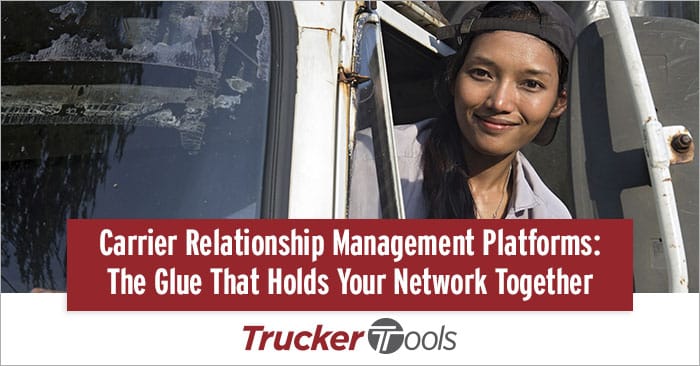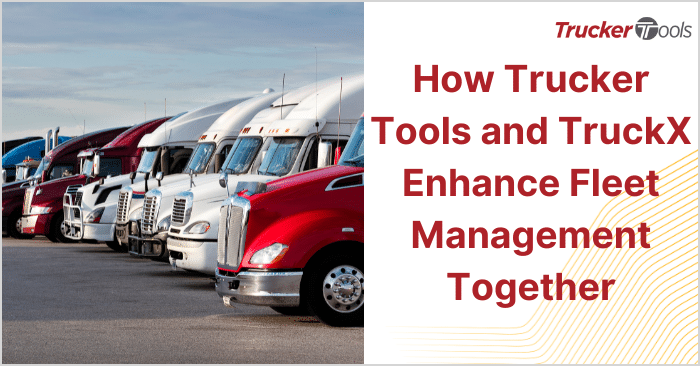In a recent webinar presented in partnership with FreightWaves, Trucker Tools’ Founder and Chief Customer Officer Prasad Gollapalli spoke about the power of carrier relationship platforms and how they help solve some of the biggest challenges carriers, 3PLs and freight brokers face today. Gollapalli was joined by FreightWaves’ VP of Media Operations Mary Anne Hensley for the webinar to discuss how these platforms can be the key to making relationships between carriers, 3PLs and brokers successful ones. As part of the discussion, Gollapalli outlined the differences between carrier relationship management platforms and digital freight brokerage and also explained how the technology fosters true relationship-building with carriers.
Carrier Relationship Management Platform vs. Digital Freight Brokerage
“We hear these questions a lot: ‘What is a carrier relationship management platform?’ and, ‘How is it different from a digital freight brokerage?’” said Gollapalli. “The biggest difference when you look at a carrier relationship management platform versus a digital freight brokerage platform is that first of all, digital freight brokerages are basically trying to override the existing model and eliminate the broker. A carrier relationship management platform is enhancing or enabling traditional freight brokers and third party logistics providers to really grow their businesses by using technology to scale faster. Perhaps more importantly, carrier relationship management platforms also help the carriers become more efficient, which is what makes these platforms more effective than traditional load boards.”
Trucker Tools’ Smart Capacity carrier relationship management platform connects freight brokers and 3PLs with the 1.7 million drivers who’ve downloaded Trucker Tools’ app and the 190,000 carriers active on Trucker Tools’ carrier platform. With Smart Capacity, you can manage carrier relationships from the time a carrier first pulls a load for you until the carrier (in an ideal scenario) joins your network.

How Carrier Relationship Platforms Create Carrier “Stickiness”
To understand how carrier relationship management platforms can increase carrier engagement, Gollapalli did a brief review of how technology has traditionally been used within transportation. Approximately 40 years ago, DAT created its load boards, which became the primary way for brokers and carriers to expand their businesses, taking the industry from whiteboards and TV monitors in truck stops to the load boards of today. It’s important to recognize, however, that the load board model is primarily a transactional model. What that means is every morning, carriers are logging into public load boards and trying to find freight. Then they move the freight and start again. Over the last decade, there’s been a push to move away from a transaction model to a more relationship-based model.
“A carrier relationship management platform provides intelligence on which lanes the carrier runs,” said Gollapalli. “A carrier relationship management platform also keeps carriers on one technology platform instead of having them jump through different platforms. Imagine this: you connect with a particular carrier on a public load board. They call you the broker and you give them that load. At that point, they’ve left the public load board. The load gets picked up and you’re tracking the load through another software, an ELD or with check calls. Once the carrier delivers that load, they submit the BOL and POD documents by FedExing them to you, through scanning and emailing the documents, or using another piece of software. There are four or five touchpoints where the carrier is getting a runaround from different systems and what happens is that the carrier typically loses connection with you. They have to actively find another way to connect with you. Any carrier relationship management platform should be connecting these dots, connecting your interaction points with your carriers.”
Gollapalli also noted that a carrier relationship management platform helps carriers piggyback on loads so that they make more money in the process. Most large carriers are able to send their trucks into markets where they know demand is high, which increases their asset utilization, whereas smaller carriers don’t have that capability and that ultimately affects their profitability. According to Gollapalli, it’s problematic for the entire industry when a carrier is inefficient because it passes along those inefficiencies through the supply chain. Using a carrier relationship management platform simplifies how carriers interact with brokers and ultimately improves carrier efficiency, which benefits the entire industry.
For more on the power of a carrier relationship management platform, watch the webinar on demand.
Schedule a free demo of Smart Capacity, Trucker Tools’ carrier relationship management platform.






